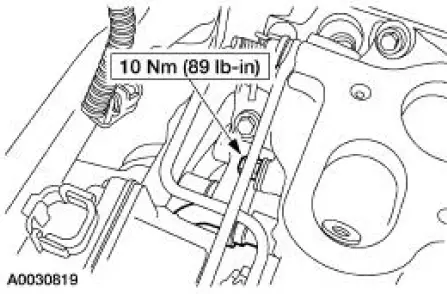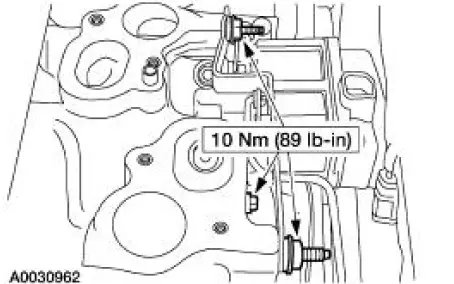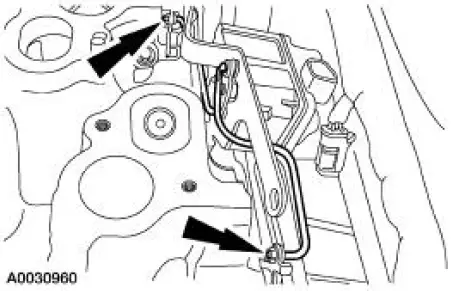Ford Mustang (1999-2004) Service Manual: Intake Manifold Runner Control (IMRC) Actuator - 3.8L
Removal and Installation
1. Disconnect the battery ground cable. For additional information, refer to Section.
2. Drain the cooling system. For additional information, refer to Section.
3. Remove the upper intake manifold. For additional information, refer to Section.
4. Remove the fuel injector supply manifold. For additional information, refer to Section.
5. Remove the coolant bypass tube. For additional information, refer to Section.
6. Remove the bolt and heater water inlet tube at the back of the lower intake.

7. Remove the two stud bolts and one bolt. Position the actuator aside.

8. Disconnect the linkage and remove the actuator.

9. NOTE: New plastic IMRC retainers must be installed any time an IMRC rod is removed.
NOTE: Before installing the IMRC actuator, be sure to rotate the motor driver plate until the levers make contact with the set screws, then rotate the motor until the motor bracket bolt holes line up with the tapped holes in the lower intake manifold.
NOTE: Discard O-ring and install a new O-ring on the heater inlet tube. Lubricate the O-ring with engine coolant prior to installation.
To install, reverse the removal procedure.
 Camshaft Position (CMP) Sensor - 4.6L
Camshaft Position (CMP) Sensor - 4.6L
Removal and Installation
1. Disconnect the battery ground cable. For additional information,
refer to Section.
2. Remove the bolts and position aside the power steering pump
reservoir.
3. ...
 Crankshaft Position (CKP) Sensor - 3.8L
Crankshaft Position (CKP) Sensor - 3.8L
Removal
1. Disconnect the battery ground cable. For additional information,
refer to Section.
2. Remove the crankshaft position (CKP) sensor.
Disconnect the connector.
Remove the bolt ...
Other materials:
Emission control system
WARNING: Do not park, idle, or drive your vehicle in dry grass
or other dry ground cover. The emission system heats up the
engine compartment and exhaust system, which can start a fire.
WARNING: Exhaust leaks may result in entry of harmful and
potentially leth ...
Acceleration Control (Description and Operation)
Component Locations
The throttle is controlled by the accelerator cable which is connected to the
accelerator pedal and
shaft.
The accelerator pedal and shaft should travel smoothly from the idle to
the wide-open throttle
(WOT) positions. Hesi ...
Mass Air Flow (MAF) Sensor - Mach I
Removal
CAUTION: The mass air flow (MAF) sensor hot wire sensing
element and housing are
calibrated as a unit and must be repaired as a complete assembly. Do not
damage the sensing
element (internal to housing) or possible failure to the mass air f ...
